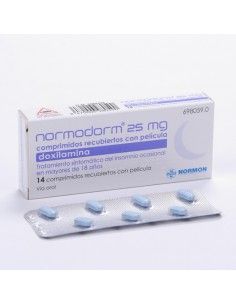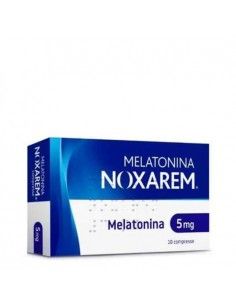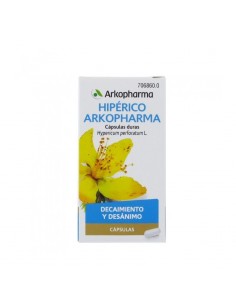Dormirel 25 mg 16 Coated Tablets
- [ANTIALLERGIC], [HISTAMINE ANTAGONIST (H-1)]. Doxylamine is an ethanolamine derivative that competitively, reversibly and non-specifically blocks H1 receptors, reducing the systemic effects of histamine. It causes vasoconstriction and decreased vascular permeability, reducing redness and oedema associated with allergies. It partially alleviates symptoms associated with allergic processes such as eye redness or nasal congestion. It also produces a slight bronchodilator effect and a reduction in skin pruritus.
- [HYPNOTIC]. Doxylamine is able to cross the blood-brain barrier and act on central H1 receptors, resulting in sedation. It appears that the sedative effect may also be due to antagonism of muscarinic and serotonergic receptors. Doxylamine has greater sedative effects than other ethanolamines.
- [MUSCARINIC CHOLINERGIC ANTAGONIST (M)], [ANTIEMETIC]. Doxylamine is a non-specific antagonist capable of blocking other receptors such as central or peripheral muscarinic receptors. Its anticholinergic effects appear to be less potent than those of other ethanolamines. The blockade of H1 and central cholinergic receptors could exert an antiemetic effect, although this has not been fully clarified.
Pharmacokinetics
Oral route:
- Absorption: Doxylamine is well absorbed in the intestine, but undergoes intense first-pass metabolism in the liver, which reduces its bioavailability. After administration of a 25 mg dose, Cmax of 100 ng/ml is reached in 2-3 hours. Sedative effects begin after 30 minutes and peak at 1-3 hours. They last for 6-8 hours.
- Metabolism: Although not adequately studied, doxylamine appears to be rapidly and almost completely metabolised in the liver.
- Elimination: Doxylamine and its metabolites are eliminated in the urine. Its elimination half-life is 10 hours.
Indications
- [INSOMNIA]. Symptomatic treatment of insomnia, particularly when there is difficulty falling asleep, frequent interruptions during sleep, or early morning awakening.
Dosage
Dosage:
- Adults, oral: 12.5-25 mg/24 hours.
- Children and adolescents under 18 years of age, oral: The safety and efficacy of doxylamine in children and adolescents under 18 years of age have not been evaluated. If it is necessary to use doxylamine in people under 18 years of age, it is recommended not to use doses greater than 25 mg/24 hours.
Treatment lasting longer than one week should be avoided.
Rules for correct administration
Doxylamine should be administered half an hour before bedtime in order for it to take effect.
Contraindications
- Hypersensitivity to any component of the medicine. Cross-reactions with other antihistamines may occur, so it is not recommended to use any H1 antihistamines in patients who have shown hypersensitivity to any compound in this group.
- [ASTHMATIC CRISIS]. According to some authors, doxylamine may worsen asthma, so its use is not recommended in acute crises.
- [PORPHYRIA]. H1 antihistamines have been associated with the onset of porphyria attacks, so they are not considered safe in these patients.
Precautions
- [RENAL INSUFFICIENCY]. Metabolites may accumulate in patients with renal insufficiency. Because these metabolites may be active, it is recommended to prolong the periods of administration in patients with moderate or severe renal insufficiency (CLcr less than 60 ml/minute).
- [HEPATIC INSUFFICIENCY]. Doxylamine is extensively metabolised by the liver. In cases of hepatic insufficiency, plasma concentrations may increase, with a consequent risk of adverse effects. A dosage adjustment may be necessary in these patients depending on the degree of hepatic function.
- Patients suffering from [GLAUCOMA], [PROSTATIC HYPERPLASIA] or [URINARY BLADDER OBSTRUCTION], [ARTERIAL HYPERTENSION], [CARDIAC ARRHYTHMIA], [MYASTHENIA GRAVIS], stricturing [PEPTIC ULCER] or [INTESTINAL OBSTRUCTION]. Due to the anticholinergic effects of doxylamine, these conditions may be aggravated, so extreme caution is recommended and treatment should be discontinued if worsening occurs.
- Diseases of the lower respiratory tract, such as [ASTHMA], [PULMONARY EMPHYSEMA] or [CHRONIC OBSTRUCTIVE PULMONARY DISEASE]. According to some authors, doxylamine may decrease the volume of bronchial secretions, increasing their viscosity, due to its anticholinergic effects, and may therefore aggravate these conditions. However, there is not much clinical evidence, despite which extreme caution is recommended in these patients. As a general rule, its use is not recommended in patients with asthma attacks (see Contraindications).
- [EPILEPSY]. Caution should be exercised in epileptic patients, as antihistamines have sometimes been associated with paradoxical reactions of hyperexcitability, even at therapeutic doses, and may therefore lower the seizure threshold.
- [APPENDICITIS]. Due to its antiemetic effects, it could interfere with the diagnosis of appendicitis. It is recommended to rule out the presence of appendicitis in patients with vomiting of unknown origin.
- Ototoxicity. Doxylamine may have a beneficial effect in cases of vertigo, tinnitus and dizziness, and may therefore mask ototoxicity induced by ototoxic drugs such as parenteral aminoglycosides, carboplatin, cisplatin, chloroquine and erythromycin, among others.
- Photosensitivity. Doxylamine may cause photosensitivity, so it is recommended to avoid sun exposure during treatment and to protect yourself with sunscreen.
- Extreme temperatures. H1 antihistamines may aggravate exhaustion-dehydration syndrome and heatstroke due to the decrease in sweating caused by their anticholinergic effects. Patients being treated with these medicines are advised to avoid exposure to very high temperatures, especially in the case of young children, the elderly or people with serious chronic illnesses. It is also advisable to follow appropriate hygiene and dietary measures, such as adequate ventilation and hydration.
Warnings about excipients:
- This medicine contains sodium salts. To find out the exact sodium content, it is recommended to check the composition. Oral and parenteral pharmaceutical forms with sodium amounts greater than 1 mmol (23 mg)/maximum daily dose should be used with caution in patients with or on low-sodium diets.
Advice for patients
- This medicine should be taken half an hour before bedtime.
- Treatment lasting longer than one week is not recommended. If insomnia persists or worsens after this time, it is recommended that you consult your doctor.
- It may cause drowsiness, so caution is advised when driving, and it should not be combined with other sedative drugs or substances such as alcohol.
- Patients undergoing treatment with sedative drugs are advised not to self-medicate with doxylamine products without consulting a doctor.
- It is advisable to avoid sun exposure during treatment.
- Any chronic conditions the patient may have should be reported to the doctor before starting treatment.
- Exposure to extreme temperatures should be avoided while using this medicine, staying in a cool environment and staying properly hydrated.
Special warnings
- Doxylamine may mask the ototoxic effects of some drugs, so it is recommended that the hearing function of patients treated with these drugs be evaluated periodically.
- Before using this medicine in patients with vomiting of unknown origin, it is recommended that appendicitis be ruled out.
- It is recommended to monitor the patient's hydration in the event of a heatwave, especially if the patient is a young child, an elderly person, or a person with a serious illness.
- Due to the anti-allergic effects of this medicine, it could give false negatives in skin tests for hypersensitivity to antigenic extracts. It is recommended to discontinue administration of this medicine at least 72 hours before the test.
Interactions
Doxylamine may mask the symptoms induced by ototoxic drugs by reducing vertigo or dizziness. Similarly, it may enhance the photosensitising effects of other active ingredients that cause photosensitivity reactions. In addition, drug interactions with the following active ingredients have been reported:
- Ethyl alcohol. The combined administration of alcohol and doxylamine could enhance the sedative effects of both substances. It is recommended to avoid alcohol consumption during treatment.
- Anticholinergics (antiparkinsonian drugs, tricyclic antidepressants, MAOIs, neuroleptics). The administration of doxylamine together with other anticholinergic drugs could potentiate the anticholinergic effects, so it is recommended to avoid this combination.
- Sedatives (opioid analgesics, barbiturates, benzodiazepines, antipsychotics). The combined administration of doxylamine with a sedative drug may enhance the hypnotic action. Extreme caution is recommended.
Pregnancy
FDA Category B. Studies in rats at doses 125 times higher than human doses have shown no risk to the foetus. However, when doses 125-375 times the maximum human dose were administered, skeletal abnormalities characterised by rib ondulation and diaphragmatic hernias were observed.
Doxylamine crosses the placenta. There is considerable controversy regarding the teratogenic effects of doxylamine. This drug has been frequently used for the prevention of gestational nausea and vomiting. Epidemiological studies have not shown any adverse effects on the foetus, although some studies have associated the administration of doxylamine during the first trimester of pregnancy with cases of cleft palate. However, no causal relationship with doxylamine has been established, and these effects have not been observed in other studies, which is why the FDA considers it unlikely that doxylamine is teratogenic. However, due to the lack of adequate and well-controlled studies in humans, it cannot be ruled out that it may be weakly teratogenic. This medicine should therefore be used with caution in pregnant women, and only if the benefits outweigh the potential risks.
Breastfeeding
Doxylamine may inhibit lactation due to its anticholinergic effects. It is unknown whether doxylamine is excreted in breast milk, but other antihistamines are. Because children are more sensitive to anticholinergic reactions and may more frequently experience paradoxical reactions of hyperexcitability, it is recommended that breastfeeding be discontinued or that this medicine be avoided.
Children
The efficacy and safety of doxylamine as a sedative in children under 18 years of age have not been evaluated. Because anticholinergic symptoms and hyperexcitability are more common in these patients, its use is not recommended.
Elderly
Elderly patients are more sensitive to the adverse effects of antihistamines, such as dizziness, sedation, confusion, hypotension, and hyperexcitability, as well as anticholinergic effects (dry mouth, urinary retention, glaucoma precipitation). Antihistamines can be used in patients over 65 years of age, but extreme caution should be exercised. If side effects persist or are severe, it is advisable to discontinue treatment.
Effects on driving
Doxylamine may substantially affect the ability to drive and/or operate machinery. Patients should avoid operating dangerous machinery, including motor vehicles, until they are reasonably certain that the drug treatment does not adversely affect them.
Adverse reactions
The side effects of doxylamine are usually mild and transient, being more frequent during the first few days of treatment. Like other ethanolamines, doxylamine mainly causes drowsiness and anticholinergic phenomena, but there is great inter-individual variability in the frequency and intensity of symptoms, affecting mainly young children and the elderly. The most common adverse reactions are:
- Digestive. [NAUSEA], [VOMITING], [CONSTIPATION], [DIARRHOEA], [EPIGASTRIC PAIN], [ANOREXIA], [DRY MOUTH].
- Neurological/psychological. [SOMNOLENCE] is common, especially at the start of treatment, and usually decreases after 2-3 days. [DISORIENTATION], [PSYCHOMOTOR COORDINATION], [MYASTHENIA], [VERTIGO], [ASTHENIA], [HEADACHE] may also occur. In exceptional cases, paradoxical [EXCITABILITY] has been observed, especially in young children. This hyperexcitability is accompanied by [INSOMNIA], [NERVOUSNESS], [TREMOR], [IRRITABILITY], [EUPHORIA], [DELIRIUM], palpitations and even [CONVULSIONS].
- Cardiovascular. In isolated cases, and usually in the event of overdose, [TACHYCARDIA], [PALPITATIONS] and other [CARDIAC ARRHYTHMIAS] such as [EXTRASYSTOLE] or [HEART BLOCK] may occur. These effects could be due to anticholinergic activity. [HYPOTENSION] or [ARTERIAL HYPERTENSION] have occasionally been reported.
- Respiratory. An increase in the viscosity of bronchial secretions may occasionally occur, which can make breathing difficult.
- Genitourinary. [URINARY RETENTION] and [SEXUAL IMPOTENCE] may occur due to cholinergic blockade.
- Haematological. [HEMOLYTIC ANEMIA], [AGRANULOCYTOSIS], [LEUKOPENIA], [THROMBOCYTOSIS] or [PANCYTOPENIA] have rarely been reported.
- Ocular. Due to anticholinergic activity, [GLAUCOMA] and [VISION DISORDERS] such as [BLURRED VISION] or [DIPLOPIA] may occur. [OTOTOXICITY] ([TINNITUS]) may also occur.
- Allergic/dermatological. [HYPERSENSITIVITY REACTIONS] may occur after systemic administration of antihistamines, although less frequently than when applied topically. [PHOTOSENSITIVITY REACTIONS] may also occur after intense exposure to sunlight, with [DERMATITIS], [PRURITUS], [EXANTEMATIC ERUPTIONS] and [ERYTHEMA].
Overdose
Symptoms: Symptoms usually appear within 30 minutes to 2 hours and tend to vary, being more severe in children and people over 65 years of age. Moderate nervous depression has been reported, with sedation and apnoea, cardiovascular collapse, hyperexcitability with insomnia, hallucinations, tremors or convulsions, and anticholinergic symptoms such as dry mouth, blurred vision and urinary retention. Fever above 41.8 °C may also occur.
In the most severe cases, especially in children, symptoms may worsen, with hypotension, convulsions, respiratory depression, loss of consciousness, coma and death. However, doxylamine poisoning rarely compromises the patient's life, and recovery is complete within 24-48 hours.
Treatment: Treatment consists of the usual measures to promote the elimination of the drug. If less than 3 hours have elapsed since ingestion, emetics may be administered, taking the necessary precautions to avoid aspiration, especially in children and the elderly. Inducing vomiting is not recommended in comatose or unconscious individuals. If emesis is contraindicated, gastric lavage may be performed and activated charcoal administered. Saline laxatives such as magnesium sulphate may be used.
The symptoms of poisoning can be eliminated with the following drugs.
- Central anticholinergic effects. Intravenous physostigmine.
- Convulsions. Slow intravenous infusion of diazepam at a dose of 0.1 mg/kg in patients who do not respond to physostigmine.
- Hypotension. Administer noradrenaline, phenylephrine or dopamine, avoiding the administration of adrenaline, which may worsen hypotension.
- Ventricular arrhythmias. Propranolol.
If necessary, intubation and assisted respiration may be used. The use of analeptics is not recommended as they may induce seizures.























